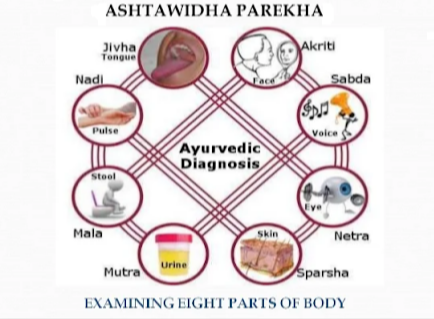Ancient Non – invasive Health Monitoring System – Ashtavidha Pariksha

Ancient Non – invasive Health Monitoring System – Ashtavidha Pariksha
Ayurveda is science of life, and it focuses on the complete physical, mental, social and spiritual health of an individual. The principles of Ayurveda are based upon Tridosha- Saptadhatu- Agni and its role in maintaining health harmony. Impairment of single or multiple elements often leads to health hazards.
For diagnosing impairment within the body or for assessing underlying changing pathophysiology, Ayurveda had mentioned a very unique, Non-invasive eightfold examination system called Ashtavidha Pariksha. Acharya Charak mentioned this unique, non-invasive diagnostic tool approximately 5000 years ago in Charak Samhita. By conducting this examination with a patient thoroughly, one can conclude impaired Dosha and its probable effects on systems of the body or can diagnose particular disease.
A very unique feature of this diagnostic tool is that it can diagnose early stage of diseases, prognosis, pre-clinical stage, probable side effects on other systems and also helps in diagnosis of root causes for particular disease.
Eightfold diagnostic tools:
1. Nadi Pariksha – (Pulse diagnostics):
According to Ayurveda, pulse is the representation of underlying Tridoshik entities of the body. It is examined with respect to its rate, volume, tension and type of pulsation. Predominant Dosha within the body can be assessed by feeling pulse at different points.
Various velocities of Nadi are also mentioned in texts like Hansa gati, Sarpa gati, Manduka gati etc.
This tool of pulse examination is very unique, pinpoint can be used for further management.

.
2. Mutra Pariksha – (Examination of Urine):
Particular questions and some tests are illustrated to be carried out for urine examination. Quantity, frequency and appearance like color, froth in urine etc. are main parameters used for assessment of underlying pathologies.
3. Mala Pariksha – (Stool Examination):
It is similarly conducted like a urine examination. Color of the stool, frequency, smell and consistency are some parameters used for diagnosing underlying vitiation of Doshas.
4. Jihwa Pariksha- (Tongue Examination):

Color of the tongue, coating on the tongue and appearance should be assessed for further diagnosis.
5. Shabda Pariksha – (Voice Examination):
Quality of voice, strength should be assessed for further diagnosis
6. Sparsha Pariksha – (Skin Examination):

Skin color, changes in skin color, texture, temperature and any discoloration should be examined for accurate diagnosis.
7. Drik Pariksha – (Eye Examination):
Complaints related eyes should be noted for knowing underlying pathophysiology.
8. Akrti Pariksha – (General appearance Examination):
General build, body physics, changes if any should be noted for conclusion of diagnosis.
By conducting an eightfold detailed examination, it is very easy to diagnose accurately. This ancient Ayurvedic medical diagnostic tool is the actual boon for accurate diagnosis and treatment.
Author:
Dr. Gayatri Kulkarni – Mulye
MD (Ayurved)
Blogger @ Turyaa Wellness
For regular updates, like and follow:
For regular updates, like and follow:

